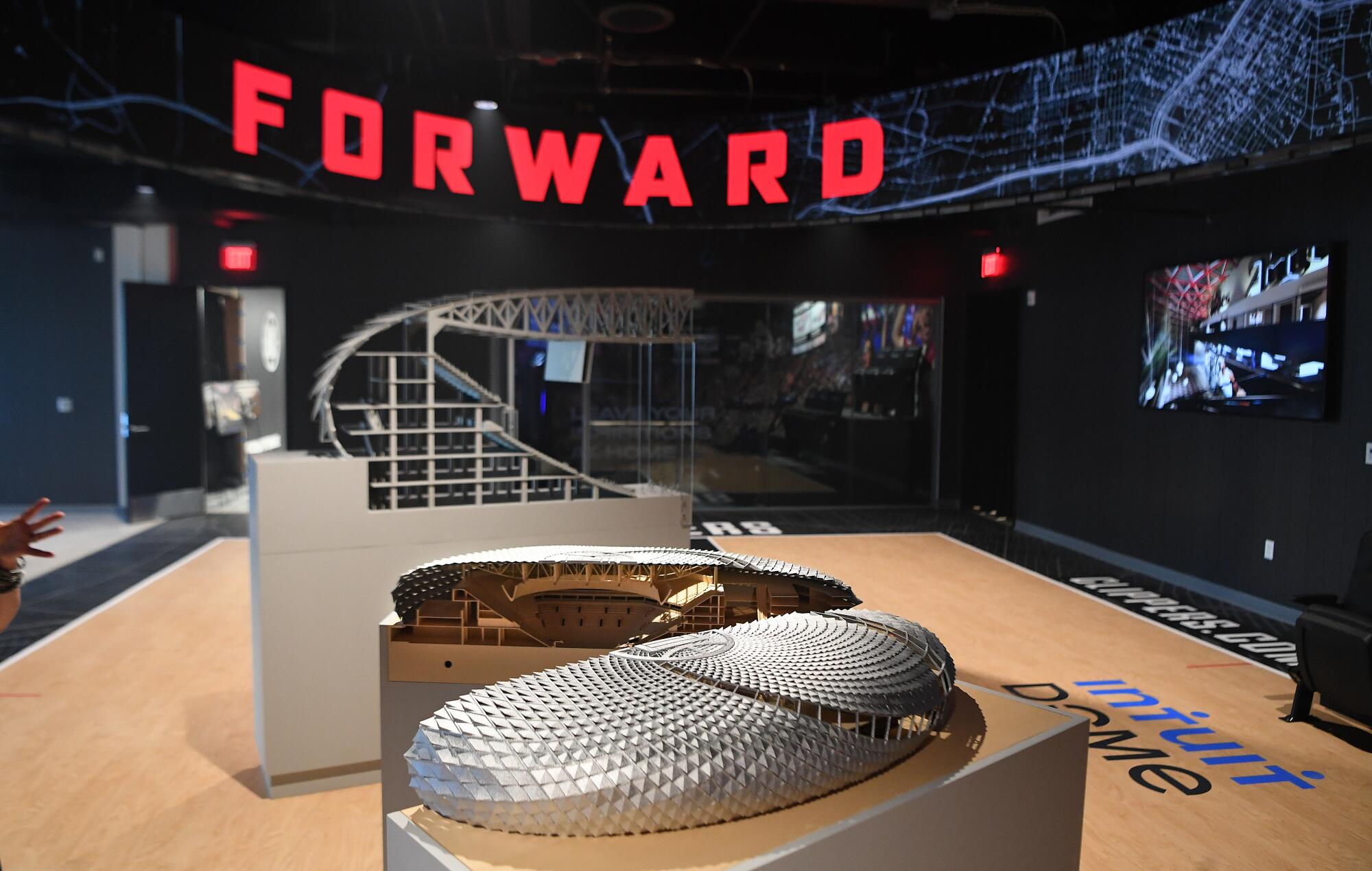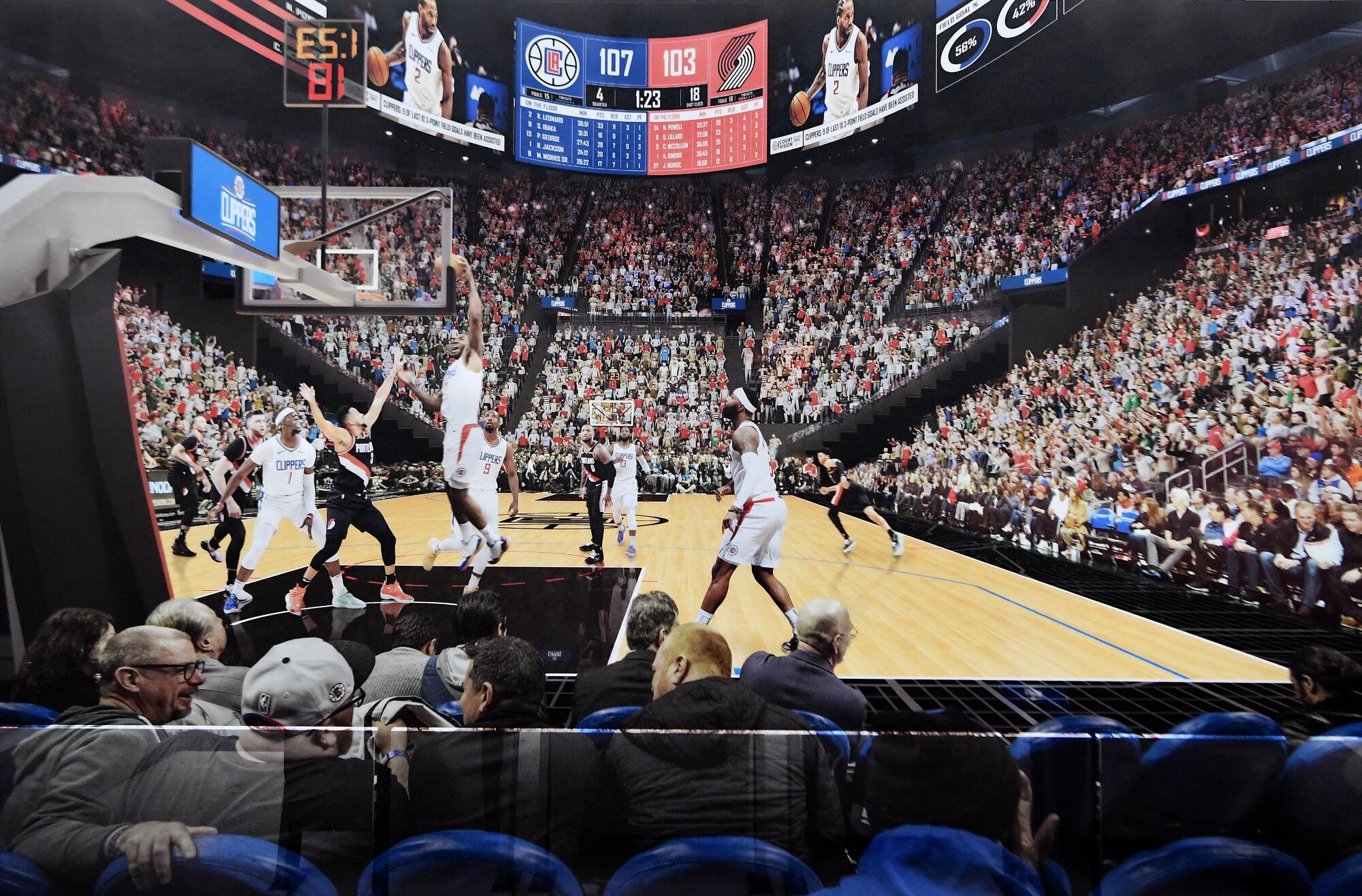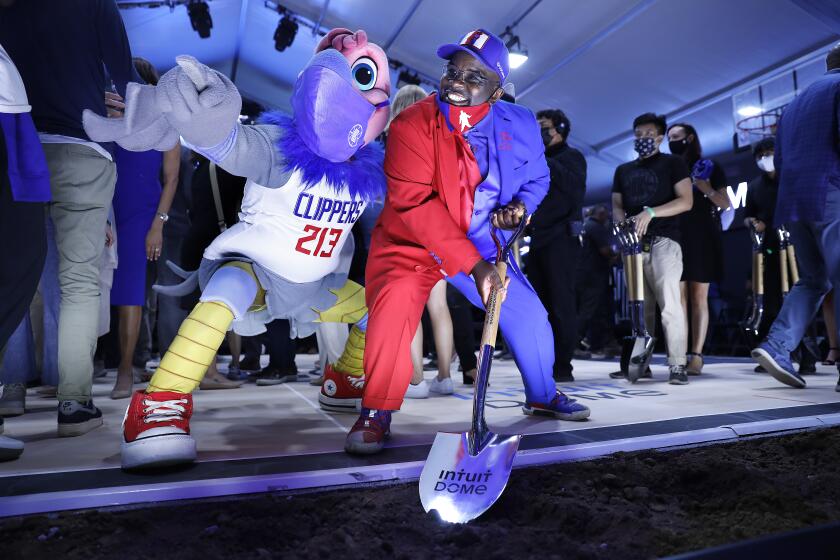
- Share via
For four years, as Clippers owner Steve Ballmer waded through costly legal fights and a lengthy environmental review process before receiving the green light to begin construction of the team’s proposed arena, his project was known by various names: the Inglewood Basketball and Entertainment Center, or Murphy’s Bowl, the Clippers-controlled company leading its development.
On Friday, Ballmer and his team will call the 28-acre site at Inglewood’s Prairie Avenue and Century Boulevard their future home.
And officially, the project’s centerpiece, an 18,000-seat arena, has its own name: The Intuit Dome.
The agreement between the Silicon Valley-based software company, known for making TurboTax, lasts 23 years, said Lara Balazs, Intuit’s chief marketing officer, who declined to say how much Intuit paid for the rights to put its name, in part, across the top of the arena. The roof is designed to look like a ball going through a net. It’s the latest high-profile spending by the company, which announced Monday it was paying $12 billion to acquire the email marketing company Mailchimp.
The Clippers will officially break ground on the project Friday morning with a ceremony featuring coach Tyronn Lue and stars Kawhi Leonard and Paul George, with construction to follow immediately as part of a tight, 36-month timeline to open on time for the start of the 2024-25 NBA season. The Clippers’ lease at Staples Center, their home arena since 1999, ends in 2024.
The Clippers don’t have to look far to understand the trouble that can come with a construction timeline featuring little room for error. The opening of SoFi Stadium, which stands across Century Boulevard from the site of The Intuit Dome, was delayed a year because of heavy rains.
Owner Steve Ballmer and Clippers fans held a groundbreaking party in Inglewood, looking forward to moving into their own home, the Intuit Dome.
“We’ll have a contingency,” Ballmer said in an interview. “I’m not going to talk about it because we won’t need it. We’re going to get the building in 2024.”
Ballmer, the former chief executive of Microsoft, said technology will play a central role in the privately funded arena and its larger campus, whose price tag is $1.8 billion, according to a disposition and development agreement prepared last year by Inglewood.
A two-sided, oval-shaped scoreboard with 44,000 square feet of LED lights — about 37,000 more square feet than a typical center-hung scoreboard in an NBA arena, the team said — will dangle over the court. Smart concession stations will scan what items fans pluck from one, eliminating the need for checkout lines, though Ballmer acknowledged some leaps forward in technology are needed to monitor sales of alcohol.
Fans will also be able to watch games from an outdoor plaza on a screen that will stretch most of the length of an outdoor, regulation-sized court, according to the team.
For as much as Ballmer and Gillian Zucker, the team’s president of business operations, described an attempt to figure out how a modern arena would operate in the future, other aspects of the design process needed to answer issues as old as stadiums themselves.
How many bathrooms? The team said it will have double the number of toilets, per fan, than any other arena.
The Clippers released artist renderings of their future home in Inglewood, which will be called The Intuit Dome. Here’s a look at what to expect.
How much leg room? Intuit Dome’s seats will have the most leg room of any NBA arena, the team said, with its upper-deck seats featuring more leg room than the current seats in Staples Center’s lower bowl.
How can home-court advantage be gained? An admirer of the tight quarters and steep pitch of the stands at Utah’s Vivint Arena, Ballmer has long loved a feature of his arena he has dubbed “The Wall,” 51 unbroken rows of stands behind one basket, a 4,700-seat section the owner hopes will become a wall of sound.
Ballmer said the project’s architect told him that he spent more time involved in the design process than most team owners pondering new stadiums, saying he enjoyed deciding some of the more minute details, such as ceiling panels in a luxury club that evoke a basketball net seen from above. The NBA’s referees association, for instance, was consulted for what will be included in their dressing room. A decision was made that “the visiting locker room was going to be primo,” he said. “You know how most visiting locker rooms kind of suck? I said, why not? Why not tell players this is a first-class organization.”
Ballmer preferred that large-screen televisions not be installed inside the “bunker suites” that allow guests low-row seats but also access to a private room, saying he wanted to encourage fans to watch the game.
“I didn’t think I had many opinions on suites,” he said. “But it turns out that I have a lot of opinions on suites.”
In search of the right home since moving to Los Angeles in 1984, the Clippers in the past frequently had a wandering eye. Negotiations to play in Anaheim collapsed in 1996 but the lure of a move persisted. When Kobe Bryant reflected in 2016 about nearly signing with the Clippers as a free agent in 2004, he said the attraction was partly because he was intrigued by the possibility of playing in Anaheim, closer to his Orange County home.

Upon purchasing the team in 2014, Ballmer said that “I didn’t want to build a building” — hesitant because he wasn’t well-versed in real estate. He credited the team’s vice chairman, Dennis Wong, with helping coordinate architects, developers and scouting land.
“It’s hard to find a location in L.A., honestly,” Ballmer said Thursday. “If you had said, ‘Hey, this wasn’t gonna work,’ it wasn’t like we had a good Plan B. There were few spots where it would’ve been impossible to put the land together even, there was one spot that became available that might have, there were options to be away.
“I really wanted to be west of the 110 [freeway], south of the 10 and north of the 105 — there just aren’t that many locations. We saw some locations that were outside and I think people would’ve said, well, you’re not really in L.A. anymore if we were playing Carson. I just think people think about those things differently. Especially for basketball, when you’ve got 41 home games as opposed to having eight” for football.
At Staples Center, the Clippers’ home since 1999, the team has made no secret of its frustration as the building’s “third tenant,” which Ballmer said leads to fewer, and less lucrative, options for tipoff dates and times, compared to the Kings and Lakers.
The Clippers will be The Intuit Dome’s sole tenant, with concerts and other events expected to fill the empty nights without basketball. Its business operations, currently housed downtown, and practice facility and basketball offices, which are now in Playa Vista, literally will all be under the same roof — whose solar panels, the team claims, will power a massive battery large enough to host an NBA Finals game while off the electric grid.
Friday morning’s groundbreaking will be Ballmer’s first time visiting the site since the final parcels of land were acquired this summer.
“It will be kind of cool,” he said.

More to Read
Go beyond the scoreboard
Get the latest on L.A.'s teams in the daily Sports Report newsletter.
You may occasionally receive promotional content from the Los Angeles Times.








